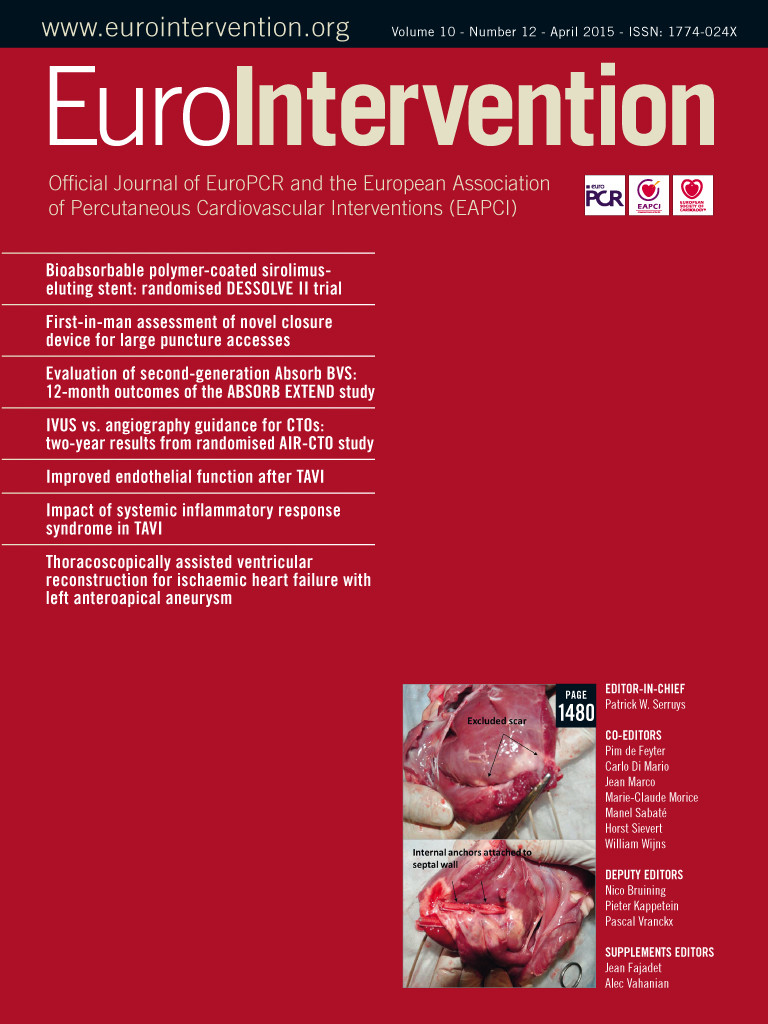The current issue of EuroIntervention presents a randomised trial that compares the results of stenting after recanalisation of CTO with or without intravascular ultrasound (IVUS) guidance. After one year of follow-up Tian et al observed a 5.2% rate of death in both groups, as well as non-significant differences for infarction 15.7% vs. 13.0%, restenosis 13.3% vs. 15.9%, stent thrombosis 0.9% vs. 2.6%, and reintervention of the target vessel 4.3% vs. 9.6% in the IVUS compared to the angio group. The results after two years of follow-up were similar1. In summary, this demonstrates again that it is pretty difficult scientifically to confirm superiority of IVUS-guided stenting when hard endpoints only are compared.
Practising high-volume coronary angioplasty since 1982, I remember the tough years when only balloon angioplasty was available, eventually followed by bail-out stenting in 1989, then still without thienopyridines. We had to administer high-dose heparin, Coumadin and aspirin, only to navigate between Scylla and Charybdis, namely acute stent thrombosis in up to 25%2 and severe bleeding complications in the range of 20%. This dilemma challenged the upcoming development of stenting as an elective strategy that was shown to cut restenosis by 10%3, and as a result many operators decided to use stents as a bail-out strategy only. In 1993, Antonio Colombo made a first important step towards fewer complications by implementing intravascular ultrasound to optimise the primary result of stenting. IVUS revealed that results which appeared angiographically acceptable should be improved by post-dilating the implant with slightly oversized balloons and high pressure, and that subsequently anticoagulation was dispensable, when an intra-stent lumen cross-sectional area equal to or larger than the distal reference lumen could be achieved4. With his favourable results in mind, we and many operators immediately adopted a “bigger is better” strategy aiming at an angiographically residual stenosis of close to 0%. We also learned that further dilatation to an angiographically residual lumen of less than 0% is detrimental5. The idea of Barragan and other French operators in 1993 of adding ticlopidine to aspirin instead of Coumadin was a breakthrough and almost resolved the problem of stent thrombosis and bleeding6,7.
The question then arose whether we still needed IVUS as an add-on to what appeared angiographically perfect, especially in view of the upcoming admirable progress in imaging quality provided by the new generation of angiography equipment with digital edge enhancement.
In the following years seven randomised trials (2,391 patients) sought to clarify whether IVUS-guided stenting with bare metal stents (BMS) was rewarding – with disappointing results: hard endpoints such as death and infarction remained similar after 2.5 years, and reintervention could be reduced by only 5% (13% vs. 18%)8. Likewise, a contemporary randomised trial by Antonio Colombo’s group using drug-eluting stents (DES) in 284 patients with complex coronary lesions including chronic total occlusions showed no beneficial effect of IVUS with respect to death, myocardial infarction, and even restenosis, reintervention or stent thrombosis after two years9. A similar disappointing failure to demonstrate superiority for IVUS-guided stenting in long lesions was independently reported in the same year by J.S. Kim10.
A very recent large observational study (ADAPT-DES) comparing 3,349 patients with IVUS-controlled DES implantation to 5,234 without IVUS guidance revealed no difference in mortality and definite stent thrombosis at one year, but 1.2% fewer myocardial infarctions11.
The most obvious limitation of this study was that IVUS patients were younger, had less advanced disease and were more likely to receive new-generation DES, suggesting a biased assignment.
In view of all these data, current European guidelines recommend IVUS only in selected patients (Class IIa, level B)12.
Why is it so cumbersome to prove a meaningful superiority for IVUS guidance? Probably because operators learned the lessons taught by IVUS, including proper stent sizing and prolonged or repetitive high-pressure deployment, either in their institution or by watching live cases at interventional courses.
PCI of chronic total occlusions is the most challenging coronary intervention, with lower success rates (about 80%), increased restenosis (about 15%) and reocclusion (about 5%) compared to non-CTO procedures13, and is therefore a good model to test IVUS as a strategy to improve the long-term results in complex lesions.
The authors of the paper in this issue of EuroIntervention therefore have to be congratulated for undertaking the huge effort of randomising 230 successfully recanalised CTO patients to IVUS-controlled optimisation versus angiography-controlled optimisation, whose IVUS results were analysed by a core lab only and not meant to be utilised by the operator after stenting.
At 12 and 24 months the rates of major adverse events including revascularisation were similar. Stent thrombosis (definite and probable) at two years occurred in six patients of the angiographically controlled group and in one of the IVUS-controlled group, but the study was underpowered for a statistically solid conclusion with respect to this event.
There is no doubt that IVUS can be very helpful to clarify anatomical structures that cannot be satisfactorily identified by angiography alone, such as in some patients with in-stent restenosis, left main disease or in some complex CTO procedures when the course or position of the retrograde wire has to be identified. However, it is somewhat disappointing that, even after more than 20 years of experience with IVUS-guided stenting, our reports still have to state: “Appropriately powered randomised trials are necessary to provide robust evidence and verify the practical value of IVUS-guided DES implantation”14, as was also correctly outlined by Tian and his co-workers in the present publication.
The reality is that added complexity, additional costs, lack of robust evidence and probably also lack of appropriate funding (induced by this lack of evidence) are the reasons why, at least in Europe, IVUS-guided PCI is applied in less than 5% of procedures15, and even very experienced CTO operators use it during their CTO procedures in fewer than 3%16.
IVUS is undoubtedly a perfect teaching tool for PCI operators but, once the lesson of how to stent is understood, its value appears debatable.
Conflict of interest statement
The author has no conflicts of interest to declare.

